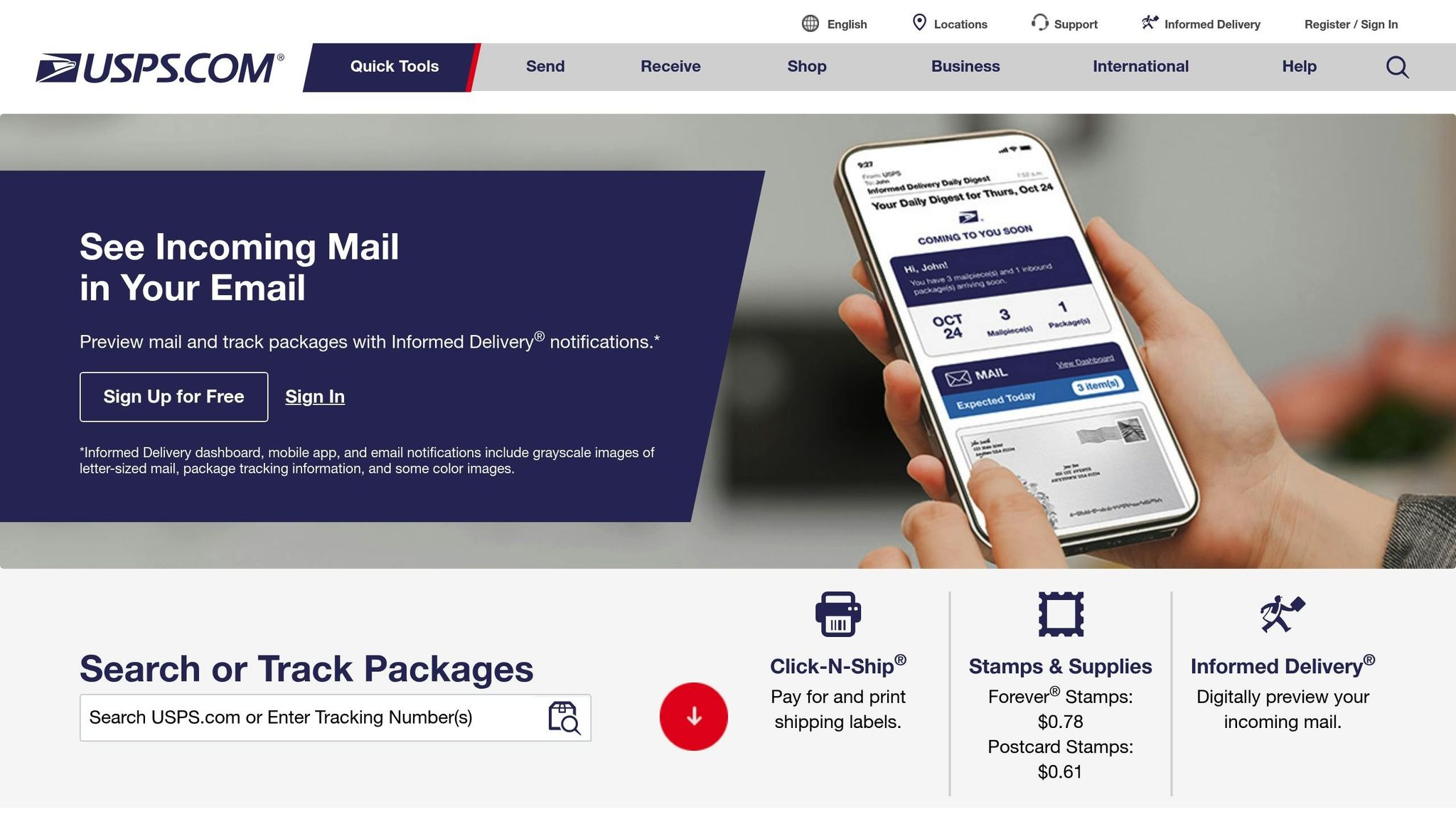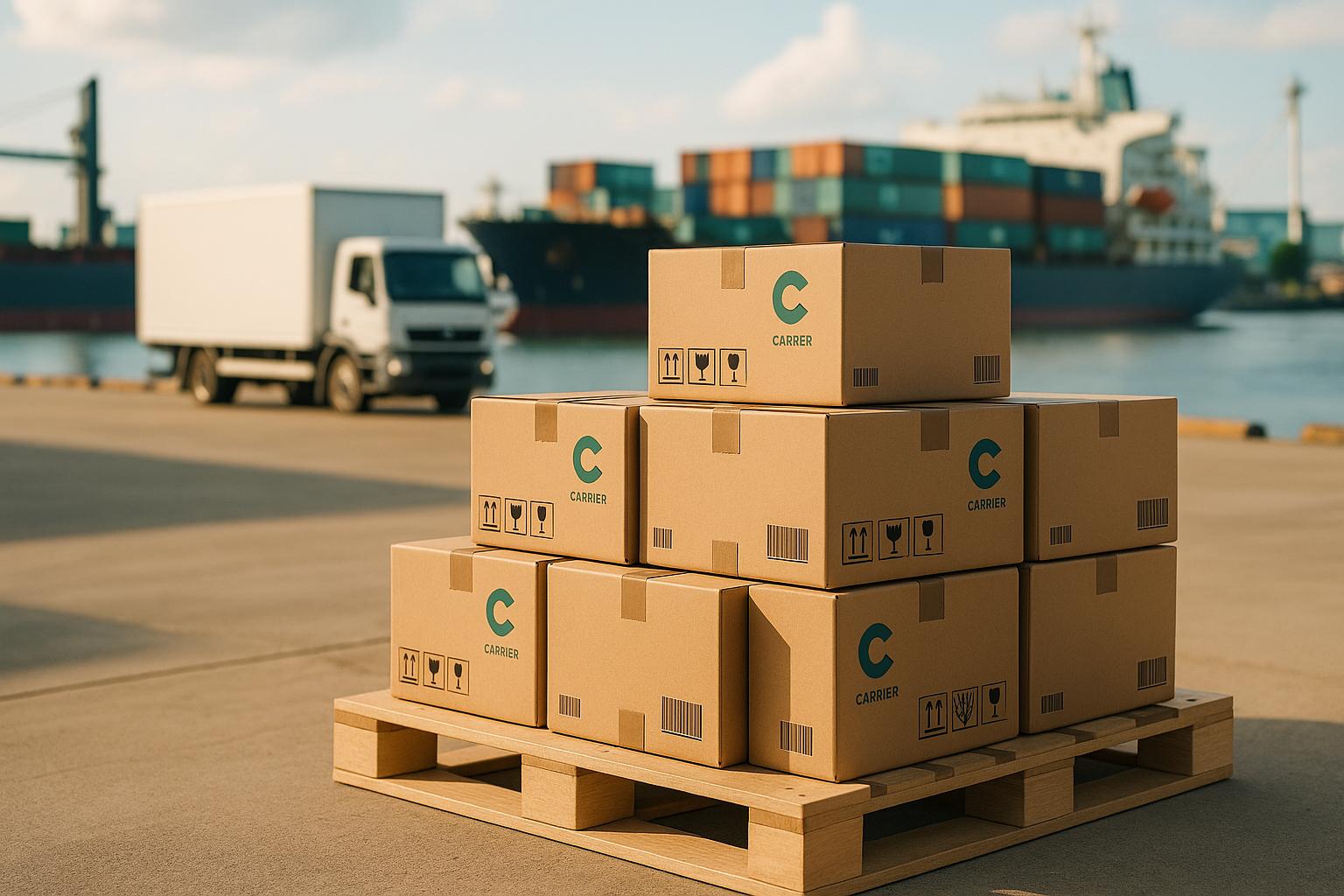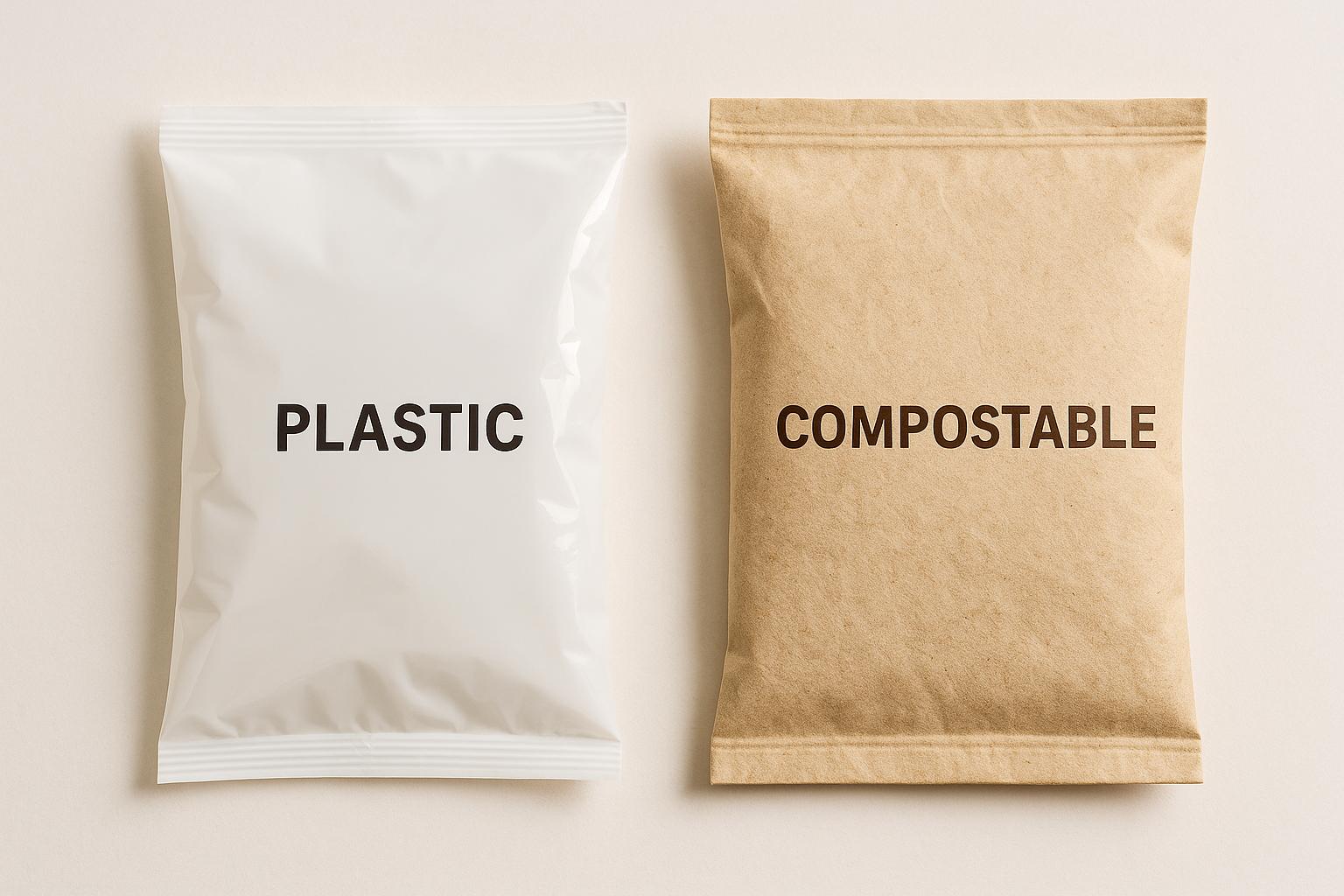When shipping products, the carrier you choose doesn’t just affect delivery - it also directly influences packaging costs. Carriers like FedEx, UPS, and USPS each have specific policies that impact box dimensions, materials, and overall expenses. Here’s what you need to know:
- FedEx uses dimensional weight pricing, so oversized boxes for lightweight items can lead to higher costs. Specific packaging rules and surcharges for irregular packages can also drive up expenses.
- UPS recently updated its dimensional weight policy, rounding up fractional inches, which increases billable weight and costs. Surcharges for large or irregular packages are common.
- USPS offers flat-rate shipping and charges based on actual weight for most domestic shipments, making it more cost-effective for smaller packages. However, nonmachinable items may incur extra fees.
Each carrier has strengths and drawbacks. FedEx excels in specialized shipping but is costly. UPS is reliable but adds surcharges. USPS is budget-friendly for lightweight packages but less reliable for on-time delivery. Optimizing packaging to align with carrier rules can help reduce costs while maintaining product safety.
The Cheapest Way To Ship A Package – USPS Vs FedEx Vs UPS

1. FedEx
FedEx's pricing structure often drives up packaging costs for CPG brands, making it a key player in how these brands approach shipping and packaging strategies. The carrier's policies and requirements can significantly influence packaging decisions, frequently pushing brands to adapt to specific shipping guidelines.
Dimensional Weight Policies
FedEx uses dimensional weight pricing to calculate shipping costs. Essentially, if the dimensional weight - calculated by dividing the package's volume by 139 for domestic shipments - exceeds the actual weight, the shipping cost is based on the larger number. This can be a headache for brands shipping lightweight items in larger boxes. For instance, a product weighing just 4 oz, shipped in a 12″ × 8″ × 4″ box, would have a much higher dimensional weight, leading to inflated shipping costs. To navigate this, brands often turn to custom-sized packaging or rethink their packaging strategies altogether to minimize these charges.
Packaging Specifications and Surcharges
FedEx has strict packaging rules that can add to material costs and complicate design choices. If a package exceeds the maximum allowed dimensions, oversized surcharges kick in. Additionally, items that don't meet standard specifications may face extra handling fees. Products with irregular shapes or fragile items often require additional protective measures, such as extra padding or cushioning, to meet FedEx's guidelines - further driving up costs.
Cost Efficiency for CPG Brands
FedEx Ground does offer competitive rates for many shipments, but navigating their policies is critical to keeping costs in check. Sticking to FedEx's recommended box dimensions and packaging guidelines can help brands avoid unnecessary surcharges. While volume discounts and loyalty programs may benefit larger brands with high shipping volumes, smaller CPG brands often struggle to offset the added expenses caused by dimensional weight pricing and surcharges.
2. UPS
UPS presents unique cost challenges for businesses, particularly when it comes to packaging. Recent updates to their policies make it essential for brands to rethink their packaging strategies to manage rising expenses effectively.
Dimensional Weight Policies
On August 18, 2025, UPS introduced a policy change that directly affects how packaging costs are calculated. The carrier now rounds up every fractional inch in a package's length, width, and height when determining dimensional weight. This adjustment, which aligns with FedEx's approach, has been nicknamed the "rounding tax" because it increases the cubic volume and billable weight of packages.
The financial implications are significant. For example, a business shipping 2,500 packages per month could see an annual cost increase of $32,678 due to this rounding policy - without any growth in shipping volume. Additionally, under standard rate structures, ground shipping costs are expected to rise by about 6.2%, while overnight services could see a 9% increase.
UPS uses the formula (Length × Width × Height) ÷ divisor to calculate dimensional weight. The divisor is 139 for Daily Rates and 166 for Retail Rates. For instance, a package measuring 10.1″ × 8.1″ × 6.1″ would be rounded up to 11″ × 9″ × 7″, which significantly increases the billable weight, especially for lightweight products.
Packaging Specifications and Surcharges
UPS imposes several surcharges that can quickly add up for brands. These include Additional Handling, Over Maximum Size, and Large Package Surcharges, all of which depend on a package's dimensions, weight, or packaging type. Packages can weigh up to 150 lbs and measure up to 108 inches in length but must also meet specific girth requirements. Failure to comply with these standards can result in fees, delays, or reclassification into higher pricing tiers.
For businesses, precise measurements are crucial to avoiding unnecessary penalties and maintaining efficient operations.
Cost Efficiency for CPG Brands
UPS's dimensional weight pricing is designed to maximize vehicle space by discouraging oversized packaging. However, this approach places additional cost burdens on shippers. To stay competitive, brands need to focus on packaging optimization, accurate measurements, and strategic fulfillment planning.
Lightweight shippers are particularly affected by UPS's rounding policy. To counter these challenges, CPG brands should consider redesigning their packaging to fit within optimal dimensional weight parameters. Custom packaging solutions, like those offered by Paking Duck, can help reduce wasted space while still protecting products effectively.
sbb-itb-e0a0838
3. USPS
The United States Postal Service (USPS) operates under a unique cost structure compared to private carriers. However, its evolving policies and specific packaging requirements can influence shipping expenses.
Packaging Specifications and Surcharges
USPS has clear rules on package size and weight. For Priority Mail, packages can weigh up to 70 lbs, with a maximum combined length and girth of 108 inches. The same weight limit applies to Ground Advantage services.
Additional surcharges come into play for nonmachinable items - those that are rigid, have clasps, strings, or uneven surfaces that can’t go through automated sorting systems. These fees vary depending on the service level.
USPS also has specific guidelines for packaging materials. While Priority Mail Express and Priority Mail include free packaging options, using your own packaging can sometimes lead to higher rates. This creates a balancing act for brands: saving costs with custom packaging versus potentially paying more in shipping fees. Understanding these rules is key to leveraging USPS's cost benefits.
Cost Efficiency for CPG Brands
Even with these restrictions, USPS provides cost-saving opportunities, especially for optimized shipments. Unlike FedEx and UPS, USPS typically charges by actual weight for domestic shipments, and its flat-rate boxes offer consistent pricing for packages up to 70 lbs.
For brands with national distribution, strategies like zone skipping can reduce both shipping times and costs. By consolidating shipments and using postal facilities closer to end customers, companies - such as subscription box services or direct-to-consumer brands - can streamline their logistics and save money.
Flat-rate and Regional Rate boxes from USPS also provide predictable pricing, especially when product dimensions align with the box sizes. Companies like Paking Duck specialize in custom packaging solutions that maximize flat-rate shipping efficiency and lower per-unit costs. Matching product dimensions to available box options is essential for protecting items while keeping costs in check.
For high-volume shippers, USPS’s Commercial Pricing programs unlock additional discounts. Brands meeting volume thresholds can access reduced rates on services like Priority Mail and Ground Advantage, making USPS an appealing choice as shipping operations grow.
Pros and Cons
Looking at the detailed carrier breakdown above, let's summarize the main trade-offs for CPG brands when it comes to packaging costs and logistics efficiency. Each carrier brings its own strengths and challenges, and understanding these can help brands decide what works best for their shipping needs and volumes.
USPS stands out as the most budget-friendly option for smaller shipments. With no residential surcharges and flat-rate shipping for packages under 20 lbs, it keeps costs low. Plus, USPS delivers to every U.S. address, including PO boxes, which private carriers can’t access. However, this affordability comes with a slight compromise on reliability, as USPS has an on-time delivery rate of 94.3%.
On the other hand, UPS offers a strong mix of reliability and performance. With a 97.5% on-time delivery rate - leading the industry - it’s a reliable choice for both high-value and bulk shipments, handling packages up to 150 lbs. UPS also provides insurance coverage up to $50,000 and invests heavily in technology (about $1 billion annually) for better tracking and delivery optimization. The downside? A variety of surcharges, including fees for residential deliveries and fuel adjustments, can make it more expensive for smaller shipments.
For specialized shipping needs, FedEx takes the lead. Whether it’s temperature-sensitive goods, perishable items, or time-critical deliveries, FedEx’s express services and advanced cold chain capabilities shine. It also offers insurance coverage up to $100,000 for qualified shippers and invests approximately $1.5 billion annually in IT advancements. However, this level of service comes at a premium, making FedEx the most expensive option for routine CPG shipments.
| Carrier | Weight Limit | On-Time Rate | Insurance Coverage | Best For | Key Drawback |
|---|---|---|---|---|---|
| USPS | 70 lbs | 94.3% | Up to $5,000 | Small, lightweight packages | Lower reliability |
| UPS | 150 lbs | 97.5% | Up to $50,000 | Balanced cost/performance | Numerous surcharges |
| FedEx | - | 95.2% | Up to $100,000 | Express/specialized shipping | Highest costs |
These trade-offs highlight how critical tailored packaging solutions are for CPG brands. For example, USPS charges based on actual weight, while UPS and FedEx use dimensional weight pricing, making packaging efficiency a key cost-saving factor.
When it comes to scaling operations, each carrier offers unique advantages. USPS’s flat-rate pricing makes cost forecasting easier as shipping volumes grow. UPS’s reliability ensures customer satisfaction during periods of rapid expansion. Meanwhile, FedEx’s specialized services become increasingly important for brands venturing into temperature-sensitive or high-value product categories.
According to the 2024 American Customer Satisfaction Index, UPS scored 82 out of 100, slightly edging out FedEx’s score of 80. These subtle differences in service quality can become more noticeable as shipping volumes increase and customer expectations rise.
Custom packaging solutions - like those from Paking Duck - can help reduce dimensional weight charges and protect products during transit. Not only does this lower shipping costs, but it also enhances product safety and boosts brand presentation.
Conclusion
Research shows that choosing the right carrier can have a bigger impact on packaging costs than many might expect. For lightweight shipments, USPS often emerges as a budget-friendly choice, while UPS is known for its reliable on-time delivery. On the other hand, FedEx typically charges a premium but offers specialized services, particularly useful for temperature-sensitive products. These patterns reflect the detailed breakdowns discussed earlier.
UPS and FedEx's dimensional weight pricing models highlight the importance of efficient packaging design. Oversized boxes can lead to higher dimensional weight charges, which can quickly inflate shipping costs. By using appropriately sized boxes, you can reduce wasted space and avoid those extra fees. Additionally, switching to lighter materials - without sacrificing protection - can further cut down shipping expenses.
Tailoring your carrier strategy to your product lineup is just as important. For example, businesses shipping lightweight, high-volume items often benefit from USPS's pricing, while those dealing with standard-sized packages might lean toward UPS for its balance of cost and reliability. Companies handling perishable goods may prioritize FedEx for its specialized services, even if it costs more.
The best results often come from experimenting with different carrier and packaging combinations. Take a beauty brand, for instance - they might use USPS for sending samples, UPS for regular orders, and FedEx for temperature-sensitive serums. A multi-carrier strategy like this, paired with optimized packaging for each scenario, can significantly lower shipping costs while enhancing delivery performance.
At the heart of all these considerations is packaging optimization. Customizing packaging to fit specific carrier requirements can turn shipping challenges into opportunities. Partnering with experts like Packing Duck can make a big difference. They offer factory-direct pricing and tailored solutions to minimize dimensional weight fees while keeping products safe. With the right approach, packaging evolves from being a cost burden to a strategic advantage.
FAQs
How can businesses reduce packaging costs by avoiding dimensional weight surcharges from carriers like FedEx and UPS?
To keep packaging costs in check and steer clear of dimensional weight surcharges, businesses should prioritize right-sizing their packaging. This means using boxes that snugly fit the product, reducing empty space, and cutting down on unnecessary void fill. Why does this matter? Smaller package dimensions directly lower shipping expenses. And starting August 18, 2025, carriers like FedEx and UPS will begin rounding up fractional inches to the next whole inch when measuring packages. That makes precise sizing and compact packaging more important than ever.
Another smart move is opting for lightweight, space-saving materials like vacuum-sealed packaging, especially for smaller items. This approach reduces volumetric weight while still keeping your products safe during transit. By refining packaging design and choosing materials wisely, businesses can trim shipping costs significantly while staying in line with carrier rules.
What are the benefits of choosing USPS for lightweight shipments over FedEx or UPS?
When it comes to shipping small, lightweight packages, USPS often stands out as the budget-friendly choice. It combines affordable pricing with dependable service, including perks like free tracking and insurance. For businesses handling lighter parcels, USPS can be a smart way to keep shipping expenses in check while maintaining reliable delivery standards.
USPS also offers added conveniences, such as free packaging supplies and no extra fees for residential deliveries. These features make it a practical option for managing small to mid-sized shipments efficiently.
How do carrier packaging requirements impact shipping costs for CPG brands?
Carrier packaging requirements play a big role in shaping shipping costs for CPG brands. These guidelines dictate the materials, dimensions, and design of packaging to ensure safe and efficient transport. Carriers typically set standards around factors like weight limits, stacking strength, and size restrictions.
To comply, brands often need to tweak their secondary packaging - this could mean resizing boxes or choosing sturdier materials. These adjustments aren't just about meeting carrier rules; they also help cut down on freight waste, prevent damage during transit, and lower overall shipping costs. By aligning packaging choices with carrier standards, brands can strike a smart balance between saving money, protecting products, and staying compliant.







.svg.png)